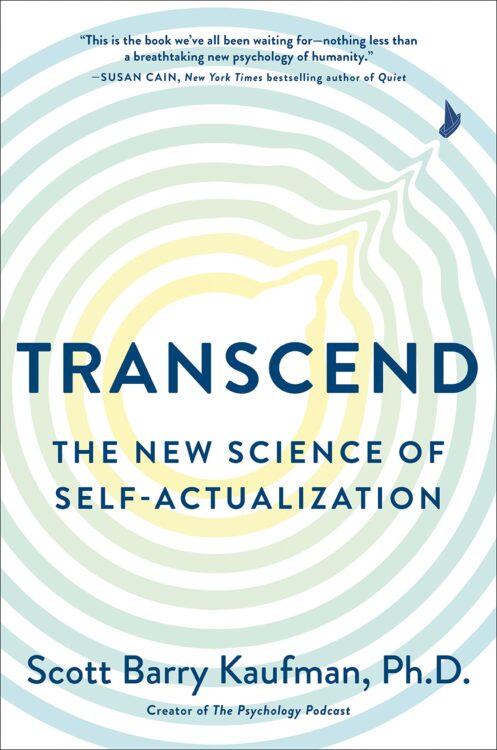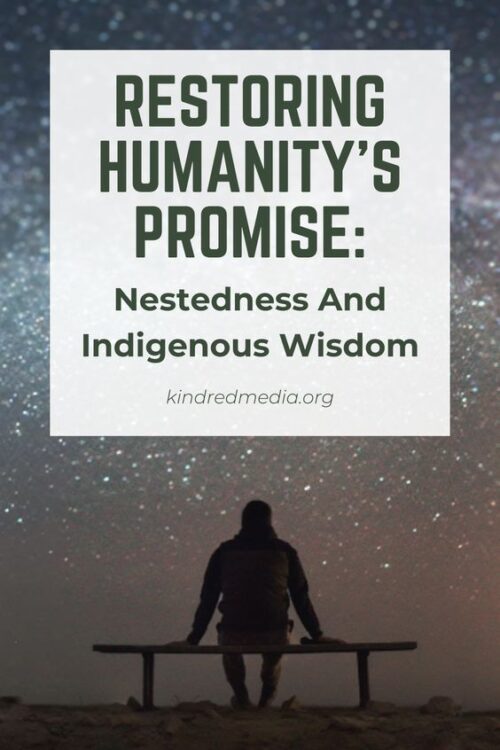Scott Barry Kaufman give us a broad and deep toolkit for self-transformation.
The goal of Scott Barry Kaufman’s book, Transcend: The New Science of Self-Actualization, is to help the reader integrate ‘everything inside.’ As Maslow suggested in his ‘Being psychology’ approach, “this requires penetrating the depths of your being with piercing awareness with the intent of experiencing the full richness of human existence,” incorporating being and becoming, deficiency and health (Kaufman, 2020, p. xx). To integrate oneself, basic needs must be met, facilitating growth towards one’s highest goals and values.
Kaufman uses the metaphor of a sailboat instead of the pyramid associated with Maslow (Maslow never used a pyramid himself). The sailboat metaphor represents the dynamism of development. When you drop your defenses, when you feel secure enough, you open your sail to move forward. Moment by moment you open or close your sail. With self-actualization, you open yourself more, allowing your boat to move further along so you can benefit from the opportunities around you. In the best of moments, you ‘catch the wind’ (enjoy peak experience).
I. SECURITY
The base of the boat represents security which involves safety, connection and self-esteem. I give a few highlights.
Safety
According to the predictive-adaptive-response theory (PAR), early childhood adversity serves as a “weather forecast” of the conditions into which the individual will mature, and it is adaptive for an individual who suffered early adversity to develop behavioral strategies attuned to the anticipated environment” (Kaufman, 2020, p. 25).
A person can be “fear conditioned” from early life stress. Over time, the fear reaction can become generalized and activated when a person or context resembles, even slightly, the original experience. The reaction happens automatically, without conscious awareness, putting one into a self-protective mode, less able to think or act flexibly (Narvaez, 2014). The person can have a general sense of the world being a dangerous place, especially the social world, affecting behavior throughout life. Though it may be easy to learn to be afraid initially, fear unlearning is a different mechanism. It is hard to unlearn these implicit fear responses. Therapy helps use reflection about such implicit feelings, take up self-monitoring to notice in which contexts they are triggered. Once identified, the individual can use awareness to adopt new behaviors and guide further healing.
Connection
Kaufman contrasts Harlow’s research with prevailing views of love and affection in mid-century USA psychology. For example, the behaviorist John Watson defined love as “an innate emotion elicited by cutaneous stimulation of the erogenous zones” and Freud described tenderness as “aim-inhibited sexuality,” a compromise for what is really desired, sex. Harlow’s experiments challenged these views, showing that young monkeys demonstrated a vital need for physical affection. Among the various benefits, experiments show that during heightened social connection, the opioid system downregulates the HPA, dampening the response to stress.
Self-Esteem
Maslow originally called self-esteem “dominance feeling” which “includes feelings of self-confidence, high self-respect, and evaluation of self; a feeling of being able to handle other people; a feeling of mastery’ a feeling that others do and ought to admire and respect one’ a feeling of general capability; an absence of shyness, timidity, self-consciousness, or embarrassment; and a feeling of pride” (Kaufman, 2020, p. 57). In contrast, those with insecure self-esteem use power to dominate others and even hurt them.
II. GROWTH
The sail on the sail boat of your personhood represents growth. Growth lies at the heart of self-actualization, what Maslow called becoming fully human. Kaufman puts three categories in the growth model: exploration, love and purpose. Some brief notes.
Exploration
Maslow wrote that healthy persons are generally unthreatened and unafraid of the unknown, rather, they accept it and are even more attracted to it than to the known.
Love
Maslow (1962/1998) explained that “Clinical study of healthier people, who have been love-need-satisfied, shows that although they need less to receive love, they are more able to give love. In this sense they are more loving people.” (p. 47)
Purpose
Maslow noted that a “eupsychian” workplace, one whose environment supports self-actualization, promotes synergy between individual, workplace and society: what is good for the individual is also good for the organization and for the society.
III. HEALTHY TRANSCENDENCE
Peak experiences are characterized by transcendence of ego and of duality (an either/or perspective); a fusion of the person with the world; loss of fears, anxieties and inhibitions along with greater acceptance of self and others; complete absorption in heightened feelings of awe. In these highest moments, Maslow noted that the true, good and beautiful seem to fuse.
In an appendix, Kaufman presents twenty “growth challenge” activities, based on the research findings presented in the book. And he presents seven principles for becoming a whole person, explaining each in kind.
Seven Principles for Becoming a Whole Person
1. Accept your whole self, not just your best self.
2. Learn to trust your self-actualizing tendency.
3. Become aware of your inner conflicts.
4. Look out for lopsided development.
5. Create the best version of yourself.
6. Strive for growth, not happiness.
7. Harness the power of your dark side.
Endorsement and Critique
This excellent book is jam-packed with research findings and with Maslow’s original, sometimes unpublished, thoughts. It engages the reader and can be read in chunks. The book provides extensive self-help guidance, including self-quizzes. Everyone, even those experienced in self-actualization practices, will find useful information and ideas.
What I find missing however are baselines for raising humans (i.e., evolved nest) and for human nature (i.e., cooperation). But this is a common problem in psychological theory and research (Narvaez & Witherington, 2018). For example, although it is known that fear conditioning occurs in early life from miscare of one kind or another and affects reactions and perceptions thereafter (without healing), researchers do not take this into account in their experiments, not assessing how early life fear conditioning is influencing the responses of research participants. Thus, when experimental results show a tendency toward self-protectionism (e.g., distrust of outgroup, concern for ingroup purity, submission to authority, deception), they are interpreted as part of human nature, even though the aforenamed characteristics are not apparent among those raised in our ancestral context where the evolved nest is provided (e.g., Ingold, 2005; Narvaez, 2013). Instead, among small-band hunter-gatherers, self-actualization is supported and taken as a normal way to exist (Turnbull, 1984; Young, Haas & McGown, 2010). Thus, one should be cautious about generalizing from experiments or studies done with WEIRD samples (Western, European, Industrialized, Rich, Democratic; Henrich, Heine & Norenzayan, 2010).
Listen to Part 23 of the Evolved Nest’s 24-part podcast series below.
Part 23: Self-Actualization. elf-Actualized people have many of the same characteristics and lifestyles. Learn what these are how you can begin implementing them in your own life to further your self-actualization.
References
Henrich, J., Heine, S. J., & Norenzayan, A. (2010). The weirdest people in the world? Behavioral and Brain Sciences, 33(2-3), 61-83.
Ingold, T. (2005). On the social relations of the hunter-gatherer band. In R.B. Lee, R.B. & R. Daly (Eds.), The Cambridge encyclopedia of hunters and gatherers (pp. 399-410). New York: Cambridge University Press.
Kaufman, S.B. (2020). Transcend: The New Science of Self-Actualization. New York: TarcherPerigee.
Maslow, A.H. (1962/1998). Toward a psychology of being (3rd ed.). New York, Wiley.
Narvaez, D. (2013). The 99%–Development and socialization within an evolutionary context: Growing up to become “A good and useful human being.” In D. Fry (Ed.), War, peace and human nature: The convergence of evolutionary and cultural views (pp. 643-672). New York: Oxford University Press.
Narvaez, D. (2014). Neurobiology and the development of human morality: Evolution, culture and wisdom. New York, NY: W.W. Norton.
Narvaez, D. (2016). Baselines for virtue. In J. Annas, D. Narvaez, & N. Snow (Eds.), Developing the virtues: Integrating perspectives (pp. 14-33). New York, NY: Oxford University Press.
Narvaez, D., & Witherington, D. (2018). Getting to baselines for human nature, development and wellbeing. Archives of Scientific Psychology, 6 (1), 205-213. DOI: 10.1037/arc0000053
Turnbull, C.M. (1984). The human cycle. New York: Simon and Schuster
Young, J., Haas, E., & McGown, E. (2010). Coyote’s guide to connecting with nature, 2nd ed.. Santa Cruz, CA: Owlink Media.




